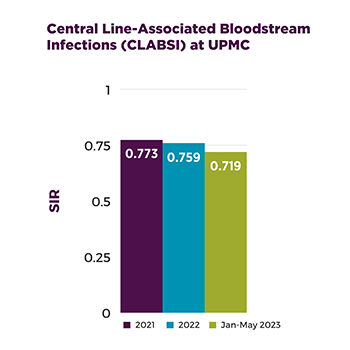What are we measuring?
An IV (intravenous) line is a small catheter that is placed into a vein in a patient's arm to give them fluids or medicine. In some cases, an IV needs to be put in a bigger vein in the neck, chest, or groin. This is called a Central Line because it is closer to the center of the body. A Central line is used when medicine cannot safely be given through a smaller IV, the patient does not have big enough veins for a smaller IV, or when therapy other than medicine is needed.
Any opening in the skin can be a risk for bacteria to enter your body. There is a chance the IV can allow bacteria on the skin to cause a skin or blood infection. The chance of a blood infection increases with the larger central IV’s that are used for longer periods of time.
How are we performing?

Image represents performance across 32 UPMC facilities.
At UPMC our goal is to reduce or eliminate the number of infections as a result of being in the hospital.
We monitor healthcare-associated infections (HAIs) across the UPMC system by using a standardized infection ratio (SIR).
What are we doing to improve?
UPMC takes many steps to prevent blood stream infections from central IV lines. We closely follow the guidance from the Centers for Disease Control and Prevention (CDC):
- The line is placed in the safest body location.
- When placing the line, the care provider thoroughly washes their hands, cleans the patient’s skin, and uses sterile technique.
- When using the line, the care provider thoroughly washes their hands and cleans the end of the line with alcohol.
- The bandage covering the IV site is inspected daily and as needed to be sure it is protecting the line from bacteria. When changing the bandage, the care provider thoroughly, uses sterile technique.
- The central line is removed as soon it is no longer necessary for care.
View the Central Line-Associated Bloodstream Infections (CLABSI) rates by UPMC hospital below:



















